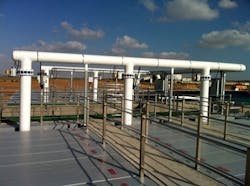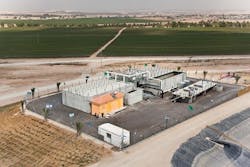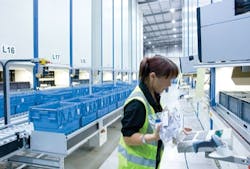Oxygen Injection Aids Force Main Odor, Corrosion Control
By Kevin Jacobs
The City of Knoxville’s collection system is a complex system of lift stations and 1,249 miles of service mains covering 108 square miles to serve 64,000 customers. Like many cities, Knoxville, TN, has a force main that was sized years ago for a projected level of industrial and residential development that has not yet been realized. Consequently, the Forks of the River force main is oversized with wastewater velocities running less than optimal.
The wastewater in the 6-mile-long force main experiences hydraulic retention times (HRT) of 18 – 24 hrs. This length of time allows for significant anaerobic conditions to develop, resulting in the generation of hydrogen sulfide gas. Over the years, the city had tried many methods and spent a great deal of money to reduce the odor production and release.
The city conducted tests to determine the level of hydrogen sulfide (H2S) released at air release valves and measured levels of up to 1000 ppm. Some of the vaults were located near heavily residential and commercial areas. To combat the problem, the city instituted a chemical treatment program using calcium nitrate at the Forks of the River pump station. This treatment reduced the odors but not to acceptable levels. The city still measured 10 mg/L of dissolved sulfide at the force main discharge and significant odor. The city sought additional new methods for preventive, non-chemical in pipe treatment to further reduce the odors to non-detectable levels.
An ECO2 SuperOxygenation system was installed one mile upstream of the Forks of the River force main discharge in November 2007. Preliminary data showed that the system successfully reduced hydrogen sulfide gas at the discharge. A second ECO2 system was installed in 2008 at the Forks of the River pump station to further reduce the H2S to near non-detectible levels as well as protect the entire length of the force main from corrosion.
Collection System Odor
The root cause of most odor problems associated with wastewater collection and treatment is H2S gas. Hydrogen sulfide is formed by Sulfate Reducing Bacteria (SRB) under anaerobic conditions resulting from the imbalance of high BOD loading and the limited solubility of oxygen in wastewater. This problem is exacerbated in long force mains and slow-cycled residential lift stations due to high microbial oxygen uptake rates, long detention times, and low dissolved oxygen (DO) levels. These anaerobic conditions produce significant amounts of H2S gas, which is both odorous and highly corrosive.
Since anaerobic conditions are precursors to H2S formation, a logical solution to H2S control is to induce aerobic or oxic conditions. SuperOxygenation is a process to sustain aerobic conditions by using an ECO2 “Speece” cone (Downflow Bubble Contactor) to dissolve pure oxygen into wastewater to raise the DO level and prevent the formation of H2S. Doing so will also eliminate the associated corrosion.
The system operates by pumping a side stream of raw, unscreened wastewater through a conical shaped oxygen transfer reactor. Gaseous oxygen is fed into the cone which generates an intense bubble swarm that has an exceptionally large gas/water interface. The inlet of the cone is sized to provide enough inlet water velocity to shear the oxygen bubbles entering the cone. The cone widens to a diameter which decreases the water velocity to a point below the buoyant velocity of the bubbles, keeping them suspended inside of the cone until they are dissolved. The system completely dissolves the gaseous oxygen into the water, realizing oxygen transfer efficiencies of 90-95%, before the water is blended back into the force main. There are no internal baffles or static mixers that could collect rags or stringy material and create maintenance problems.
The ECO2 SuperOxygenation system is designed to meet the dissolved oxygen requirements of the wastewater process that it is treating. To prevent the formation of H2S within a force main, a positive DO level must be carried through the entire length. The amount of oxygen needed is determined by multiplying the HRT by a conservative oxygen uptake rate. Once the oxygen need is determined, the SuperOxygenation system and side stream pump are sized to deliver the appropriate amount of oxygen.
The Forks of the River force main is 24” in diameter and has an average flow of 800 gpm traveling 35,194 feet from the pump station to the discharge. These parameters result in an HRT of 18-24 hours. Dissolved oxygen can be added according to the available pressure in the force main as the saturation point of oxygen increases with pressure.
The available pressure in the Forks of the River force main was insufficient to allow for enough DO to be added at the pump station to maintain aerobic conditions through its length. A secondary site was needed to add additional oxygen to carry the length of the force main. This particular force main also had a number of high and low points. A second system was added to capitalize on the pressure available at a low point.
The first system located at the pump station used the 174 ft of head pressure available to add approximately 170 mg/L of DO. This dissolved oxygen carries through to the midpoint location. The available pressure at the midpoint location allows for approximately 60 mg/L of DO to be added to carry through to the force main discharge.
Untreated, the force main generated H2S levels averaging 158 ppm with periods up to 1,000 ppm at the force main discharge. Since the two oxygenation systems came online in 2008, there has been a significant reduction in average H2S levels.
WW
About the Author: Kevin Jacobs is a Design Engineer with ECO Oxygen Technologies, LLC. More information about the company and its systems may be found at www.ECO2tech.com.
More WaterWorld Current Issue Articles
More WaterWorld Archives Issue Articles




